BUFFALO 09101577-0 Air Station (High Power Wireless Router) User Manual WHR HP G54 Manual indd
BUFFALO INC. Air Station (High Power Wireless Router) WHR HP G54 Manual indd
BUFFALO >
Contents
- 1. Manual 1
- 2. Manual 2
- 3. Manual 3
- 4. Manual 4
- 5. Manual 5
Manual 5
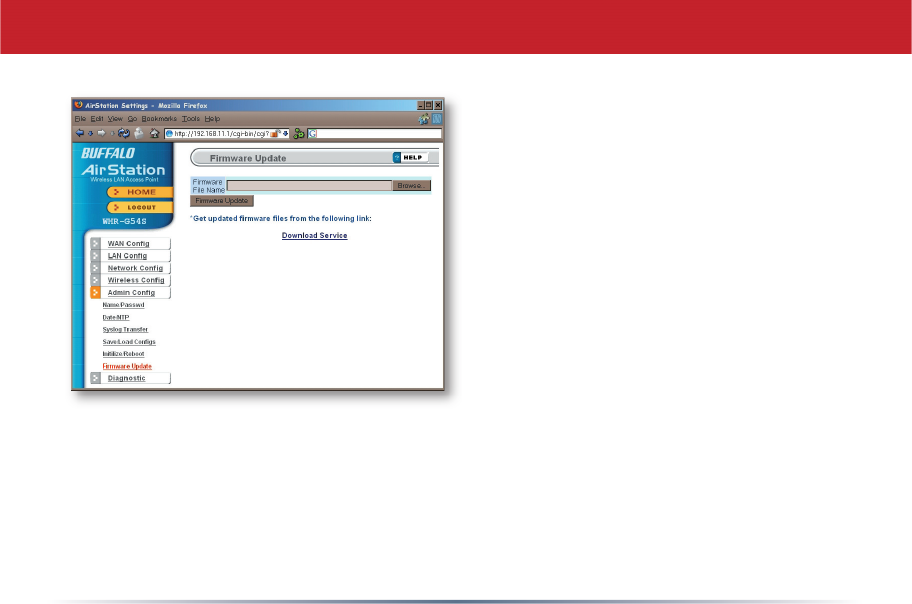
51
Click Browse to select your fi rmware
update fi le. Then, click the Firmware
Update button to update fi rmware.
Firmware Update may take several
minutes to complete. Do not power
down the router until Firmware
Update is fi nished and the diag light
on the front of the router has stopped
blinking.
When available, updated fi rmware
may be downloaded from
www.buffalotech.com.
Firmware Update
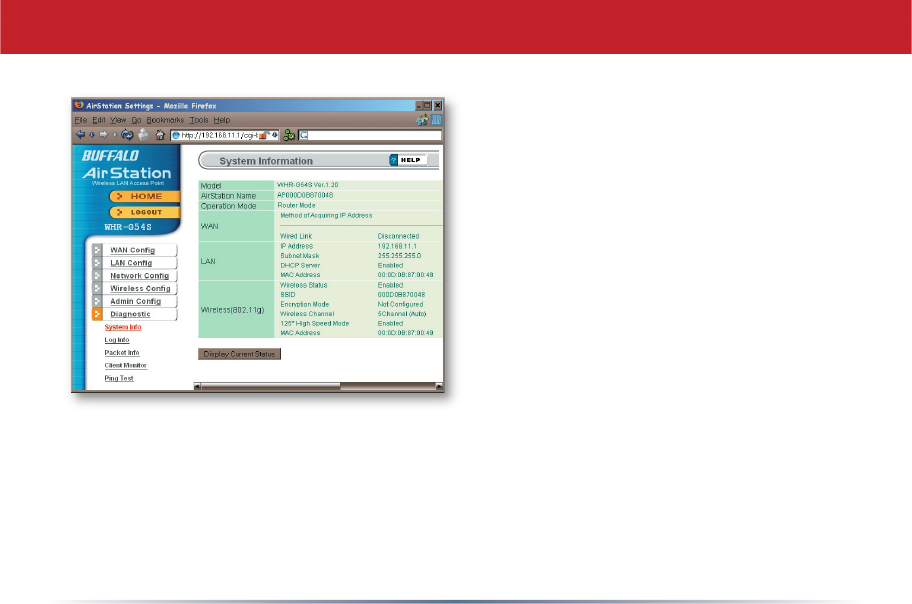
52
The System Information page lists all the
setup information for your AirStation.
It can be very handy for setting up
clients that don’t support AOSS.
System Information
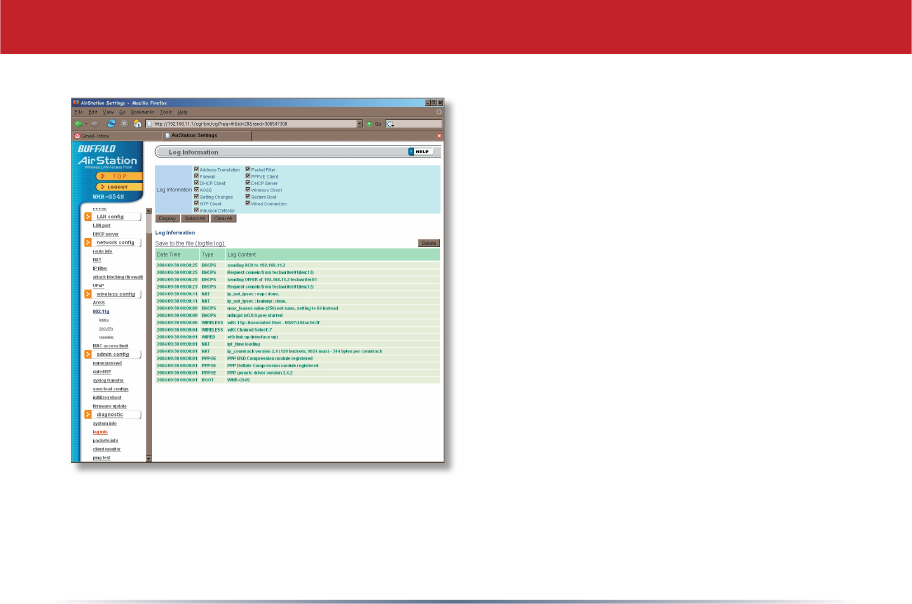
53
Here you can choose what information
gets logged and see recent log entries.
Log Information
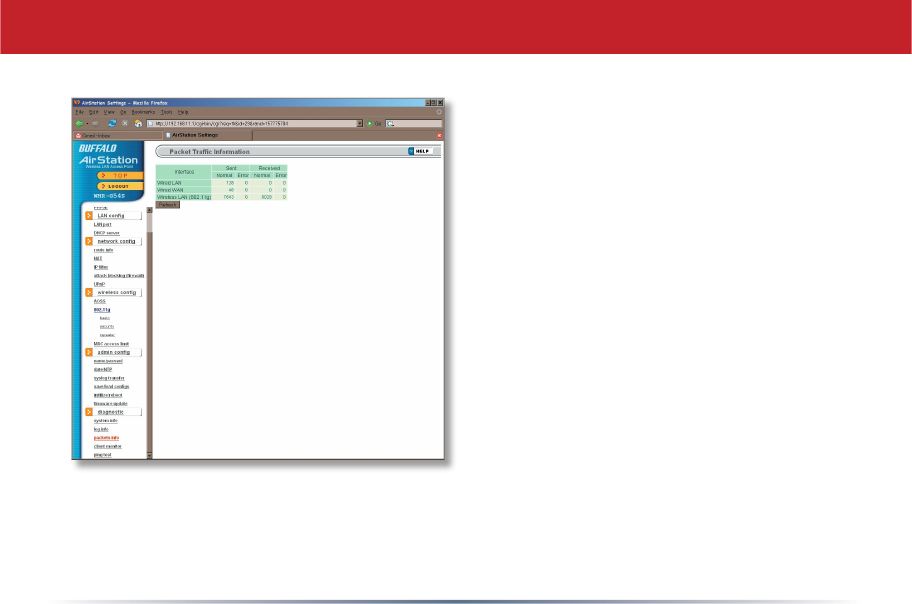
54
Here, you can see the packets and
errors for each of your networks.
Packet Traffi c Information
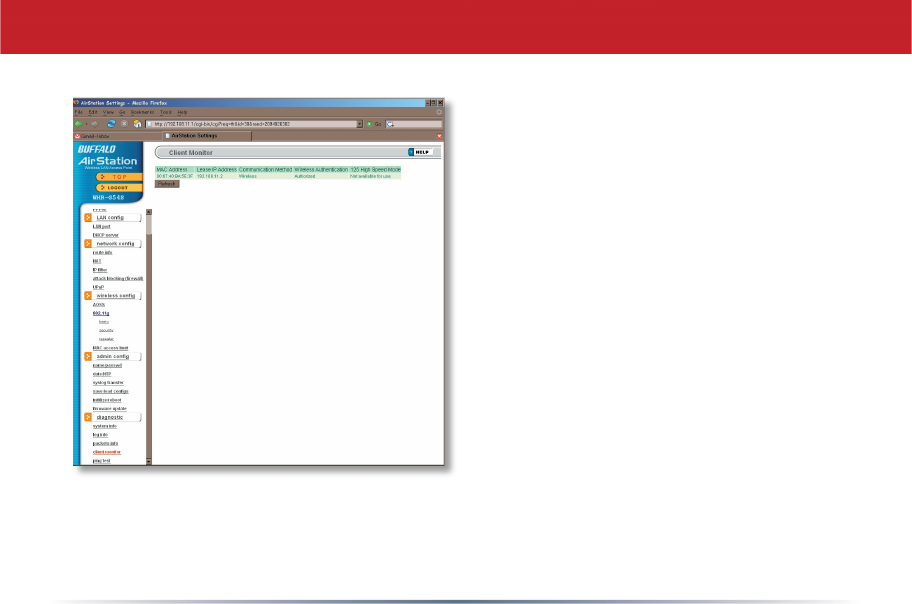
55
Client Monitor shows you a list of all
clients currently connected to the
wireless network.
Client Monitor
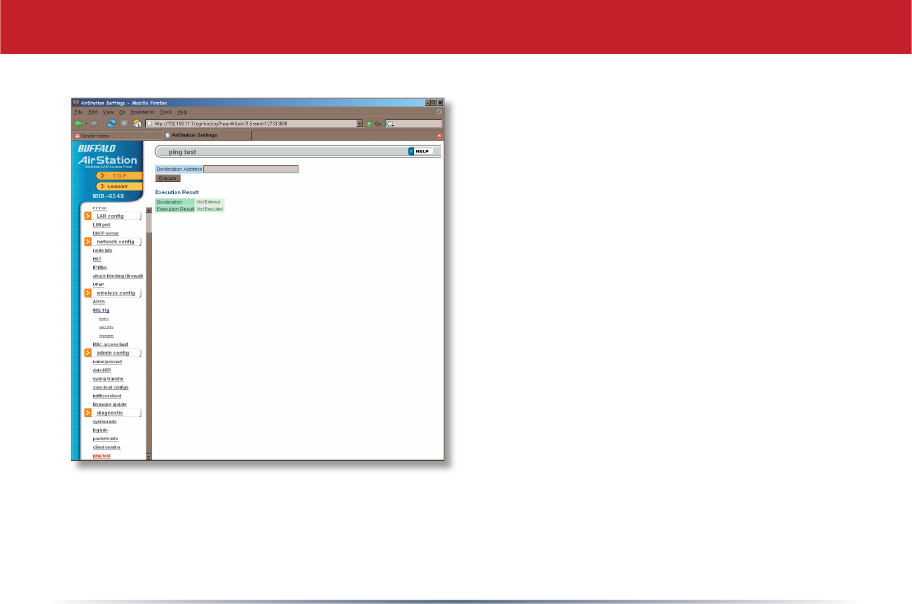
56
To perform a Ping test, enter a target
(such as 192.168.11.2 or www.
buffalotech.com) and click Execute.
Successful pings return “64 bytes
from . . .” messages. If the ping
returns “Connection failed” or other
errors, something is preventing you
from communicating successfully with
your target.
Ping Test

57
Connecting to a Preexisting Network
Add an AirStation without changing your existing LAN confi guration
1. Set the AirStation into Access Point Mode by moving the switch on the bottom from
AUTO to BRI.
2. Connect one of the AirStation’s LAN ports to an existing router or switch on your
network. Nothing should be plugged into the WAN port.
3. Open LAN Settings - LAN Port Settings and confi gure the following settings:
IP Address =[192.168.11.1] (Specify an unused network address from the existing LAN.)
Subnet Mask=[255.255.255.0] (Use the same Subnet Mask as the existing LAN.)
DHCP Server Function=[Disable]
4. Restart PC.
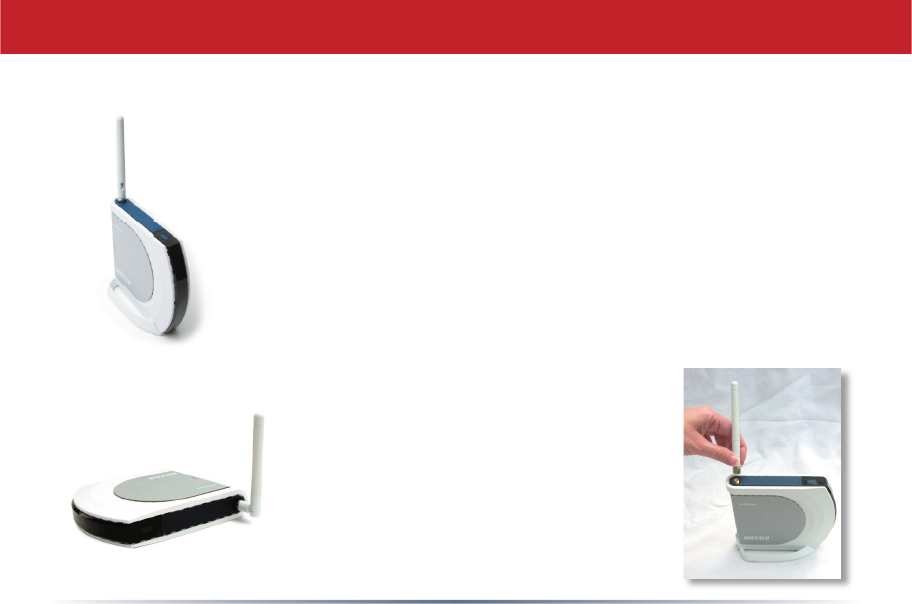
58
The WHR-HP-G54’s external antenna will usually give the best
performance if oriented to point straight up. If your AirStation is
resting on its side, use the antenna’s swivel and twist function to
orient it pointed upward.
In some environments it’s desirable to further increase range by
installing an external, higher-gain antenna. External antennas come
in all shapes and sizes. Antennas also come with different connectors.
The WHR-HP-G54 has an RP-SMA connector on it. If your antenna
has a different kind of connector, you’ll need an adaptor.
To install a different antenna, unscrew the stock antenna from
the RP-SMA connector on top of the AirStation, and screw on the
connector or adaptor from your new antenna.
Antenna

59
For more information, FAQ’s, and updates, consult the AirStation website at
http://www.buffalotech.com.
WHR-HP-G54 AirStation Specifi cations
Physical Specifi cations
Dimensions 1.1 x 5.1 x 5.7 in. (28 x 130 x 144mm)
Weight 9.8 oz. lb. (277g)
Temperature & Humidity
Operation 0˚ to 40˚ C
Maximum humidity 80%
Transit/Storage 0˚ to 40˚ C maximum humidity 80% (no condensation)
Power Characteristics
Transmit Mode 1.1A (Nominal),
Power Supply 5 V output; 100-240V AC Universal, 50/60 Hz
Power Consumption about 6.5 Watts (Max)
Specifi cations

60
Regulatory Information
Wireless communication is often subject to local radio regulations. Although AirStation
wireless networking products have been designed for operation in the license-free 2.4
GHz band, local radio regulations may impose limitations on the use of wireless commu-
nication equipment.
Network Compatability
IEEE802.11g/b Standard for Wireless LANs (125* High Speed Mode also Available.)
Wi-Fi (Wireless Fidelity) certifi ed by the Wi-Fi Alliance.
Host Operating System
Microsoft Windows® 98SE/ME/NT4.0/2000/XP, Unix, Linux and MacOS
Media Access Protocol
Wired - CSMD/CD (Collision Detection)
Wireless - CSMD/CA (Collision Avoidance) with Acknowledgment (ACK)
Radio Characteristics
RF Frequency Band 2.4 GHz (2400-2483 MHz)
Specifi cations

61
11 selectable channels (3 non-overlapping)
Modulation Technique Direct Sequence Spread Spectrum
• ODFM for High Transmit Rate
• DQPSK for Standard Transmit Rate
• DBPSK for Low Transmit Rate
Spreading 11-chip Barker Sequence
Nominal Output Power: 19dBm (802.11b), 16dBm (802.11g)
Transmit Rate:
High Speed 54 Mbps (125 Mbps in 125* High Speed Mode)
Medium Speed 36 Mbps (96 Mbps in 125* High Speed Mode)
Standard Speed 2 Mbps
Low Speed 1 Mbps
Open Offi ce Environment
160 m (525 ft.)
270 m (885 ft.)
400 m (1300 ft.)
550 m (1750 ft.)
Specifi cations

62
Semi-Open Offi ce Environment
50 m (165 ft.)
70 m (230 ft.)
90 m (300 ft.)
115 m (375 ft.)
Closed Offi ce
25 m (80 ft.)
35 m (115 ft.)
40 m (130 ft.)
50 m (165 ft.)
Receiver Sensitivity -83 dBm -87 dBm -91 dBm -94 dBm (depends on data rate)
Delay Spread (at FER of <1%) 65 ns 225 ns 400 ns 500 ns (depends on data rate)
• The range of wireless devices can be affected by metal surfaces, solid high-density
materials and obstacles in the signal path.
Table “Radio Characteristics” lists the typical ranges when used indoors:
• In Open Offi ce environments, clients can “see” each other, i.e. there are no physical
obstructions between them.
• In Semi-open Offi ce environments, work space is separated by room dividers; client
cards are at desktop level.
• In Closed Offi ce environments, workspace is separated by fl oor-to-ceiling brick walls.
Specifi cations

63
Note:
The range values listed in Table “Radio Characteristics” are typical distances as
measured at Buffalo Technology AirStation laboratories. These values are provided for
your guidance but may vary according to the actual radio conditions at the location
where the AirStation product is installed.
AirStation IEEE 802.11 Channel Sets
The range of the wireless signal is related to the Transmit Rate of the wireless
communication. Communications at a lower Transmit range may travel longer distances.
Center Channel ID FCC
1 2412 2 2417 3 2422 4 2427 5 2432 6 2437 7 2442 8 2447 9 2452 10 2457
11 2462 11 default channel
Specifi cations

64
Common Problems
• Out of range, client cannot connect to the AirStation.
• Confi guration mismatch, client cannot connect to the AirStation.
• Absence or confl ict with the Client Driver.
• Confl ict of another device with the AirStation hardware.
LED Activity
Monitoring LED activity helps identify problems.
• Power LED should be Green,
• Wireless LED should be Green if the line is active. If is it blinking Green, wireless
communication is active.
• Ethernet LED should be Green (100Mbps) or Amber (10Mbps) while the
communication is active.
• The Red Diag LED will fl ash during boot and fi rmware updates.
DIAG LED Activity
Unplug the power for three seconds. Plug the power back in to monitor the Diag LEDs
during start-up.
Troubleshooting

65
DIAG LED Activity Table
DIAG LED Display Time Description/Action
Continuous Red Starting RAM Error Red fl ash, 2 times Starting Flash
ROM Error
Red fl ash, 3 times Starting A problem on the wired LAN side
Red fl ash, 4 times Starting A problem on the wireless LAN side
LEDs Work But Client PC Cannot Connect to Network
If the LEDs indicate that the network is working properly (Power LED is on, Transmit/
Receive LED blinks), check the TCP/IP settings of the network.
Changing Client TCP/IP Settings in Windows
Consult the LAN Administrator for correct TCP/IP settings.
To add or change TCP/IP Settings:
1. On the Windows task bar, click Start.
2. Select Settings, then Control Panel.
3. Double-click on the Network icon to view Network Properties.
4. From the list of installed components, verify the TCP/IP => wireless LAN adapter
protocol is installed.
Troubleshooting

66
• If the wireless adapter protocol is not yet installed, click the Add button and select
the TCP/IP protocol from the list. Refer to Windows Help for more information.
• If the wireless adapter protocol is installed, select the protocol and click the
Properties button. Verify that the parameters match the settings provided by your
LAN Administrator. Make changes if necessary, and click OK.
5. If prompted, restart your computer.
Other Problems
Please refer to www.buffalotech.com for further reference materials.
Troubleshooting

67
Troubleshooting WDS
The most common issue with WDS installations is using the wrong MAC address. The
proper MAC Address for the access points is the Wireless MAC Address. The best place
to get this from System Information in the confi guration tool.
Restrictions:
1. All wireless access points in the wireless bridge need to support WDS. At time of
publication, only Buffalo G54 and Apple Airport Extreme access points support WDS.
2. No single access point can communicate with more then six other access points in the
wireless bridge.
Good Practices:
1. Start the wireless bridge system with only two access points and then add more, one at
a time.
2. Setup all access points in the wireless bridge in close proximity before deploying them
to their fi nal location.
3. Only one access point in the wireless bridge should be serving DHCP and routing
services unless a routed wired network exists.
Troubleshooting

68
Setting up WDS; the long version:
1. It is recommended that all access points in the bridge are reset to their factory default settings.
This is done by holding the INIT button on the rear of the access point down for 5-10 seconds.
2. Login to the fi rst access point in the wireless bridge (this should be the DHCP server enabled
access point if there is not already a routed wired network).
3. Click on the Advanced button.
4. The wireless settings page will appear. Select the proper settings for the wireless network. Record
all settings on a piece of paper. All settings except for the SSID need to be identical amongst all
access points in the bridge. If roaming is desired, then set the SSID settings identically as well. Press
the Set button if any changes are made.
(NOTE: If the IP address was changed, then reconnecting to the access point for confi guration will
require accessing it via its new IP address in a web browser (e.g. http://NEW_IP_ADDRESS). Write
down the new IP address carefully if you changed it, and put it in a safe place!
5. Click on the LAN port link on the left.
6. Check that the LAN side IP address values are correct for your network, or leave them at their
defaults. Record the LAN side IP address. Press the Set button if any settings on this page have been
set.
7. Click on the Management link on the left.
8. The System Information page will appear. In the Wireless section of the table record the MAC
address (including the colons). Please make sure the MAC address is recorded from the Wireless
section and not the other sections.
Troubleshooting

69
9. Logout of the access point by clicking on the Logout link on the left. Close the browser window.
10. Login to the second access point in the wireless bridge.
11. Click on the Advanced Settings tab.
12. The wireless settings page will appear. Select the proper settings for the wireless network. Refer to
the settings recorded from the fi rst access point. All settings except for the SSID need to be identical
amongst all access points in the bridge. If roaming is desired, then set the SSID settings identically as
well.
13. Click on the LAN port link on the left.
14. Make sure that the LAN side IP address setting is different than that of the fi rst access point. The
IP addresses cannot be the same, but they should be on the same network. It is recommended that the
IP address of the second access point is one higher then that of the fi rst access point. Thus, if access
point one’s address is 1.1.1.1, then access point two’s address should be 1.1.1.2. If there is a DHCP
server function setting on this page, then make sure to set it to Disabled. Press the Apply button when
fi nished. If the IP address was changed, then reconnecting to the access point for confi guration will
require accessing it via its new IP address in a web browser (e.g. http://NEW_IP_ADDRESS).
15. Click on the Wireless bridge (WDS) link on the left.
16. Enable WDS and press the Apply button. If desired, move the switch on the bottom of the WHR-
HP-G54 from AUTO to BRI to disable normal router functionality (optional).
17. Enter the Wireless MAC Address of the fi rst access point (which was recorded on Step 8) into the
fi eld MAC Address of AirStation (Wireless) (include the colons). Press the Add button.
18. The Wireless MAC address inputted on the step above will appear in the Connected AirStation table.
Confi rm that enable is checked, and then press the Apply button.
Troubleshooting

70
19. At the top of the page, press the Apply button.
20. Once the router has rebooted, click on the Management tab on the left.
21. The System Information page will appear. In the Wireless section of the table record the MAC
address (including the :’s). Please make sure the Wireless MAC address, and not the wired MAC
address, is recorded.
22. Logout of the access point by clicking on Logout at the top of the page. Close the browser window.
23. Login to access point one again.
24. Click on the Advanced Settings tab.
25. Click on the Wireless bridge (WDS) link on the left.
26. Enable the WDS function and press the Apply button.
27. Enter the Wireless MAC Address of the fi rst access point (recorded in Step 21) into the fi eld that
says MAC Address of AirStation(Wireless) (include the :’s). Press the Add button.
28. The Wireless MAC address inputted on the step above will appear in the Connected AirStation
table. Please check that the checkbox by enable is checked, and then press the Apply button.
29. At the top of the page, press the Apply button.
30. Once the router has rebooted, click on the Management tab on the left.
31. Click on the Ping Test link on the left.
32. In the Destination fi eld enter the IP address of the second access point and press the OK button.
Troubleshooting

71
a. If the Result section of the table reports information like “1st: 64 bytes from IP_ADDRESS” then
the WDS bridge is effectively working.
b. If the Result section of the table reports “Destination Host Unreachable”, then an error has
occurred during the setup.
WDS is a complicated bridging system with a lot of variables. If there are still problems with WDS
confi guration on the network, please contact Buffalo Tech Support (see pages 82 and 83).
Troubleshooting

72
10BaseT: 802.3 based Ethernet network
that uses UTP (Unshielded twisted pair)
cable and a star topology. 10 Mbps data
tansmission speed.
100BaseT: 802.3 based Ethernet network
that uses UTP (Unshielded twisted pair)
cable and a star topology. 100 Mbps data
tansmission speed.
1000BaseT: 802.3 based Ethernet
network that uses UTP (Unshielded twisted
pair) cable and a star topology. 1000 Mbps
data tansmission speed.
802.1x: The standard for wireless LAN
authentication used between an AP and a
client. 802.1x with EAP will initiate key
handling.
Access Point: A hardware device that acts
as a communication hub for Clients (users
of wireless devices) to connect to a wired
LAN.
Ad-Hoc Network: A network based on
peer-to-peer communication rather than a
router, switch, or hub.
Bandwidth: The transmission capacity of
a computer or a communication channel,
usually stated in Megabits per second
(Mbps).
Bridge: A device which forwards traffi c
between network segments with a common
network layer address, based on data link
layer information.
Client: A PC, workstation, or other device
that connects to a network wirelessly
through an Access Point.
Cross-Over Cable: A UTP cable that has its
transmit and receive pair crossed to allow
communications between two devices.
Default Gateway: The IP Address of either
the nearest router or server for the LAN.
Glossary

73
Destination Address: The address portion
of a packet that identifi es the intended
recipient station.
DHCP (Dynamic Host Confi guration
Protocol): Based on BOOTP, it uses a pool
of IP addresses, which it assigns to each
device connected to it, and retrieves the
address when the device becomes dormant
for a period of time.
DNS (Domain Name System): System
used to map readable machine names into
IP addresses.
Driver: Software that interfaces a
computer with a specifi c hardware device.
Dynamic IP Address: An IP address that
is automatically assigned to a client station
in a TCP/IP network, typically by a DHCP
server.
Ethernet: The most widely used
architecture for Local Area Networks
(LANs). It is a shared-media network
architecture. The IEEE 802.3 standard
details its functionality.
Ethernet cable: A wire similar to telephone
cable that carries signals between Ethernet
devices. It is designed to connect a single
device’s NIC to a router, switch, or hub.
See also Crossover cable.
File and Print Sharing: A Microsoft
application that allows computers on a
network to share fi les and printers.
Firmware: Computer programming
instructions that are stored in a read-
only memory unit rather than being
implemented through software.
Frame: A fi xed block of data, transmitted
as a single entity. Also referred to as a
packet.
Glossary

74
Full-Duplex: To transmit on the same
channel in both directions simultaneously.
Half-duplex: To transmit on the same
channel in both directions, one direction at
a time.
Hub: A device which allows connection
of computers and other devices to form a
LAN.
IEEE (Institute of Electrical and
Electronics Engineers): The professional
organization which promotes development
of electronics technology.
IP (Internet Protocol) Address: A unique
32-binary-digit number that identifi es each
sender or receiver of information sent in
packets.
Infrastructure: A wireless network or
other small network in which the wireless
network devices are made a part of the
network through the Access Point.
ISP (Internet Service Provider): A
company that provides access to the
Internet and other related services.
IV (Initialization Vector): The header
section of an encrypted message packet.
LAN (Local Area Network): A group
of computers and peripheral devices
connected to share resources.
LED (Light Emitting Diode): The lights
on a hardware device representing the
activity through the ports.
MAC (Medium Access Control) Address:
The unique number that distinguishes
every network interface card.
Mbps (Mega Bits Per Second): A
measurement of millions of bits per
second.
MDI/X (Media Dependent Interface/
Cross-over): Port on a network hub or
switch that crosses the incoming transmit
lines with the outgoing receive lines.
Glossary

75
PCMCIA (Personal Computer Memory Card
International Association) Card: Removable
module that adds features to a portable
computer.
Peer-to-peer: This simple network is formed by
connecting computers directly, without use of
routers or hubs. A crossover cable is plugged
into an Ethernet port in each computer,
connecting them directly.
Ping (Packet Internet Groper): An Internet
utility used to determine whether a particular
IP address is accessable.
Plug and Play: Hardware that, once physically
installed, fi nishes its installation automatically
and may immediately be used, as opposed
to hardware that requires further manual
confi guration.
PoE (Power over Ethernet): A mechanism
to send DC power to a device using a CAT5
Ethernet cable.
MHz (MegaHertz): One million cycles per
second.
NAT (Network Address Translation): An
internet standard that enables a LAN to
use one set of IP addresses for internal
traffi c and a second set for external traffi c.
NIC (Network Interface Card): An
expansion card connected to a computer
so the computer can be connected to a
network.
Packet: A block of data that is transferred
as a single unit, also called a frame or a
block.
Packet Filtering: Discarding unwanted
network traffi c based on its originating
address or its type.
PCI (Peripheral Component
Interconnect): A bus that is connected
directly to the CPU.
Glossary

76
PPPoE (Point-to-Point Protocol over
Ethernet): A specifi cation for connecting
users on an Ethernet line to the Internet
through a common broadband medium.
Protocol: A standard way of exchanging
information between computers.
RADIUS (Remote Authentication Dial
In User Service): A server that issues
authentication keys to clients.
RAM (Random Access Memory): Non-
permanent memory.
Repeater Hub: A device that collects,
strengthens and transmits information to
all connected devices, allowing the network
to be extended to accommodate additional
workstations. See also Bridge.
RC4: The encryption algorithm used by
WEP.
RJ-45 connector: An 8-pin connector
used between a twisted pair cable and a
data transmission device.
ROM (Read Only Memory): Memory
hardware that allows fast access to
permanently stored data but prevents
addition to or modifi cation of the data.
Router: A device in a network that
handles message transfer between
computers. Similar to a hub, but with
added functionality and effi ciency.
Roaming: The ability to use a wireless
device while moving from one access point
to another without losing the connection.
Server: Any computer that makes fi les or
peripheral devices available to users of the
network and has a resident Network OS.
SMTP (Simple Mail Transfer Protocol):
The protocol used to defi ne and deliver
electronic mail (E-mail) from one location
to another.
Glossary

77
SNMP (Simple Network Management
Protocol: An application layer protocol
that outlines the formal structure for
communication among network devices.
Static IP Address: A permanent IP
address is assigned to a node in a TCP/IP
network. Also known as global IP.
STP (Shielded Twisted Pair): Twisted Pair
cable wrapped in a metal sheath to provide
extra protection from external interfering
signals.
Subnet Mask: An eight-byte address
divided into 4 parts separated by periods.
TCP/IP (Transmission Control Protocol/
Internet Protocol: Protocol used by
computers when communicating across
the Internet or Intranet.
TKIP (Temporal Key Integrity Protocol):
An encryption method replacing WEP.
TKIP uses random IV and frequent key
exchanges.
Topology: The shape of a LAN (Local Area
Network) or other communications system.
Twisted Pair: Cable that comprises 2
or more pair of insulated wires twisted
together.
UDP (User Datagram Protocol): A
communication method (protocol)
that offers a limited amount of service
when messages are exchanged between
computers in a network. UDP is used as
an alternative to TCP/IP.
Uplink: Link to the next level up in a
communication hierarchy.
UTP (Unshielded Twisted Pair) cable:
Two or more unshielded wires twisted
together to form a cable.
WAN (Wide Area Network): A networking
system covering a wide geographical area.
Glossary

78
WEP (Wired Equivalent Privacy): A
security protocol for wireless local area
networks defi ned in the 802.11b standard,
using a 64 bit or 128 bit key. WEP was
designed to provide the same level of
security as that of a wired LAN. However, it
has been found that WEP is not as secure
as once believed.
Web Browser: A software program that
allows viewing of web pages.
Wi-Fi (Wireless Fidelity): An organization
that tests and assures interoperability
among WLAN devices.
Wire Speed: The maximum speed at
which a given packet can be transferred
using Ethernet and Fast Ethernet standard
specifi cations.
WLAN (Wireless LAN): A LAN topology
using wireless devices.
VPN (Virtual Private Network): A security
method to connect remote LAN users to a
corporate LAN system.
Glossary

79
Notice
This equipment has been tested and found to comply with the limits for a Class B digital
device, pursuant to part 15 of the FCC Rules. These limits are designed to provide reasonable
protection against harmful interference in a residential installation.This equipment generates,
uses and can radiate radio frequency energy and, if not installed and used in accordance
with the instructions, may cause harmful interference to radio communications. However,
there is no guarantee that interference will not occur in a particular installation. If this
equipment does cause harmful interference to radio or television reception, which can be
determined by turning the equipment off and on, the user is encouraged to try to correct
the interference by one or more of the following measures:
•Reorient or relocate the receiving antenna.
•Increase the separation between the equipment and receiver.
•Connect the equipment into an outlet on a circuit different from that to which the receiver
is connected.
•Consult the dealer or an experienced radio/TV technician for help.
This device complies with Part 15 of the FCC Rules. Operation is subject to the following
two conditions: (1) this device may not cause harmful interference, and (2) this device must
accept any interference received, including interference that may cause undesired operation.
In accordance with FCC regulation, BUFFALO has limited the WHR-HP-G54 to operation
on channels 1-11 by USA specific firmware.
FCC Warning
Changes or modifications not expressly approved by the party responsible for compliance
could void the user’s authority to operate the equipment.
FCC RF Radiation Exposure Statement
This equipment complies with FCC radiation exposure limits set forth for uncontrolled
FCC / CE Information

80
equipment and meets the FCC radio frequency (RF) Exposure Guidelines in Supplement C
to OET65. This equipment should be installed and operated with at least 20cm and more
between the radiator and person’s body (excluding extremities: hands, wrists, feet and
legs). This transmitter must not be co-located or operating in conjunction with any other
antenna or transmitter.
Safety
This equipment is designed with the utmost care for the safety of those who install and
use it. However, special attention must be paid to the dangers of electric shock and static
electricity when working with electrical equipment. All guidelines of this manual and of the
computer manufacturer must therefore be allowed at all times to ensure the safe use of
the equipment.
EU Countries intended for use
The ETSI version of this device is intended for home and office use in Austria, Belgium,
Denmark, Finland, France (with Frequency channel restrictions), Germany, Greece, Iceland,
Ireland, Italy, Luxembourg, Norway, The Netherlands, Portugal, Spain, Sweden, Switzerland
and United Kingdom. The ETSI version of this device is also authorized for use in EFTA
member states Iceland, Liechtenstein, Norway and Switzerland.
EU Countries not intended for use
None.
Potential restrictive use
France: Only channels 10,11,12, and 13.
FCC / CE Information

81
Warranty Information
Buffalo Technology (Melco Inc.) products come with a two-year limited warranty from the
date of purchase. Buffalo Technology (Melco Inc.) warrants to the original purchaser the
product; good operating condition for the warranty period. This warranty does not include
non-Buffalo Technology (Melco Inc.) installed components. If the Buffalo product malfunctions
during the warranty period, Buffalo Technology/(Melco Inc.) will, replace the unit, provided
the unit has not been subjected to misuse, abuse, or non-Buffalo Technology/(Melco Inc.)
authorized alteration, modifi cations or repair.
All expressed and implied warranties for the Buffalo Technology (Melco Inc) product line
including, but not limited to, the warranties of merchantability and fi tness of a particular
purpose are limited in duration to the above period.
Under no circumstances shall Buffalo Technology/(Melco Inc.) be liable in any way to the
user for damages, including any lost profi ts, lost savings or other incidental or consequential
damages arising out of the use of, or inability to use the Buffalo products.
In no event shall Buffalo Technology/(Melco Inc.) liability exceed the price paid for the product
from direct, indirect, special, incidental, or consequential damages resulting from the use of
the product, its accompanying software, or its documentation. Buffalo Technology/(Melco
Inc.) does not offer refunds for any product.
@ 2003 Buffalo Technology (Melco, Inc.)

82
Contact Information
Buffalo Technology (USA), Inc.
4030 West Braker Lane, Suite 120
Austin, TX 78759-5319
GENERAL INQUIRIES
Monday through Friday
8:30am-5:30pm CST
Direct: 512-794-8533 | Toll-free: 800-456-9799 | Fax: 512-794-8520 | Email:
sales@buffalotech.com
TECHNICAL SUPPORT
North American Technical Support by phone is available 24 hours a day, 7 days a week.
(USA and Canada).
Toll-free: (866) 752-6210 | Email: info@buffalotech.com

83
Buffalo Technology (Europe), Inc.
176 Buckingham Avenue,
Slough, Berkshire, SL1 4RD
United Kingdom
GENERAL INQUIRIES
Email: sales@buffalo-technology.com
TECHNICAL SUPPORT
Technical Support in Europe is available between the hours of 9am-6pm (GMT) Monday to
Thursday and 9am-4:30pm (GMT) Friday for this product. Customers in Europe can obtain
Technical Support using the following information:
E-mail: helpdesk@buffalo-technology.ie | Web: www.buffalo-technology.com
Contact Information

84
* When operating in High-Speed Mode, this Wi-Fi device achieves an actual
throughput of up to 34.1 Mbps, which is equivalent to the throughput of
a system following 802.11g protocol and operating at a signaling rate of
125 Mbps.
125* High Speed Mode